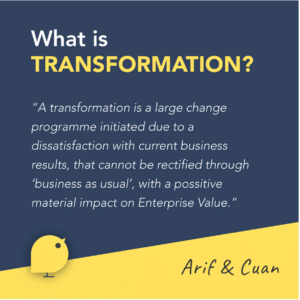Your business transformation checklist- signs your project is worthwhile

Delivering a successful transformation has never been so important, COVID-19, lockdowns, disruption, BREXIT, and if you spend any time online reading about transformations, you can become disheartened:
- The Wall Street Journal ran a survey of directors, CEOs and senior executives which found that transformation risk was their #1 concern in 2019.
- The Harvard Business Review states 70% of large-scale transformations fail to meet their goals.
- Forbes/Towers Watson reports that only 25% of change management initiatives are successful over the long term.
Transformation success may be the difference between your business surviving or collapsing into the scrapheap of history, fortunately, there is a way to make them far more likely to succeed.
The Transformation Checklist
- Get clear on what is a transformation
- Understand why current transformations fail
- Design, really design your transformation
- Setup your transformation delivery capability that is designed to mitigate the normal pitfalls of change
1. What is a transformation?
Large scale change or a transformation is perhaps one of the most overused and misunderstood terms in business today. It seems like almost every project or programme is labelled a transformation, but this creates the wrong behaviours and the wrong outcomes.

From this, rather long, the definition you can derive four tests you need to check to confirm you are doing a transformation.
Test 1: Large-scale change programme
A transformation is a “big change”. It is a large-scale change programme that makes a significant impact on your organization.
If you are expanding your company down the road, that is far less likely to be a transformation then an overseas expansion.
Test 2: Dissatisfaction with current business results
Transformations are hard and require tough decisions and senior board focus. You really need that real imperative to carry out the transformation, or the hard decisions that are required to deliver, just won’t be made.
Test 3: Cannot be achieved through business as usual
A transformation is a risky endeavour and should only be undertaken when absolutely necessary. If your target can be achieved through BAU, do that.
For example, if your objective is to increase sales by 1%, then this should be achievable through business-as-usual operations in your current region. Your existing sales teams should be able to meet this target without going through the risk and tax of a transformation.
However, if your objective is to increase sales by 100%, then it’s unlikely that your current market or operational teams would be able to achieve that without a transformational change programme.
Test 4: Positive material impact on Enterprise Value
At the end of the transformation, the value of your business should be disproportionately higher than the cost of the transformation. There is a lot of risk in implementing a transformation, therefore, it needs to be offset by a large reward.

2 – Why do transformations fail
My experience over many years of leading transformations, advising transformation teams and also viewing transformations from a distance, I saw some common patterns and created the 5 dysfunctions of transformation that you need to address to make your transformation more likely to succeed.

3 – Design your Transformation
To design your transformation, you need to do the following 4 activities:
- Establish your transformation Outcome – This is the measurable and compelling positive impact on your organization’s Enterprise Value that will be created through this overseas expansion.
- Understand your organisation’s Current performance – capture the current ways of working, how they contribute to current performance.
- Create your Transformation expansion plan – Every company’s plan will be different, there is no pre-canned plan. However, we strongly advise that every initiative is clearly linked to some contribution to the overall outcome. This is fundamental to helping you prioritise the way forward.
- Get ready – Formal approval to release funds and start the work is key, however ensuring that you have a reliable mechanism to track progress is fundamental. Your ability to measure the progress of your transformation can not be overstated. Invest properly in this capability or else you will be flying blind in delivery.
4 – Deliver your Transformation
Once you have a solid design of your transformation, it’s time for the rubber to hit the road and you can start to deliver. Each transformation is unique, however, there are some core principles that you can follow to increase the chance of success and ensure that you are on the right track.
- Establish a formal blocker removal capability. Every project or initiative will get blocked at some stage, sometimes it’s something external, like a government policy that you can do little about, however, there are a significant number of blockers that are caused from within your company, for example, legacy governance. It must be the leadership’s number one priority to help resolve blockers and get the flow of value running again.
- Install dual accountability into the transformation team. Most organisations have a top-down only accountability model, where the delivery teams are held accountable for delivery, this is not enough. It’s key that these delivery teams are empowered to hold the more senior people in the transformation team accountable for the rapid removal of the identified blockers.
- Beware of reporting watermelons. Most large scale change programmes have so many moving parts that the reports generated to update leadership on progress are overwhelming and the leadership barely have enough time to consume them before they are out of date. The volume of data in these reports can also keep the conversations at the surface level rather than going deep into the source of the data and challenging the integrity of the data in those reports. There are always watermelon reports (reporting a green status, but in reality it’s red), you need to hunt them out and upgrade them. This links back to the getting ready phase of the transformation design.
If you follow this checklist you will be giving your transformation the greatest chance of success. If you would like a more detailed step by step playbook on now to follow these steps get in touch or check out our playbook on delivering large scale change.





